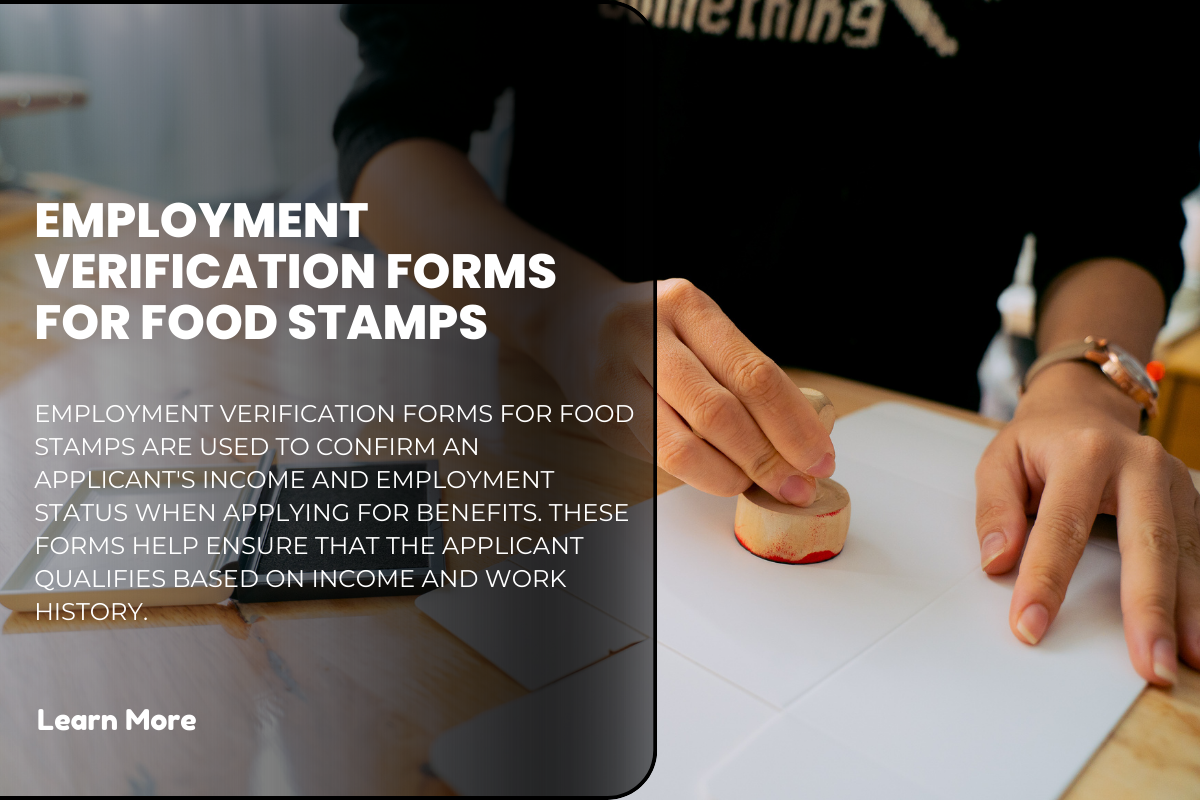 Introduction to Employment Verification Forms for Food Stamps
Introduction to Employment Verification Forms for Food Stamps
What Is an Employment Verification Form for Food Stamps?
An employment verification form for food stamps is a key document used in the application process for the Supplemental Nutrition Assistance Program (SNAP), commonly referred to as food stamps. This form serves as proof of a household’s income, employment status, and overall financial eligibility to receive assistance. The purpose of the form is to ensure that applicants meet the income guidelines set by the government and to verify that the details provided are accurate.
In the context of food stamps, the employment verification form plays a pivotal role in determining whether an individual or household qualifies for benefits. It allows the relevant authorities to assess whether an applicant’s income is within the limits for eligibility. Without proper verification, applicants may face delays or even denials of benefits, so the importance of this form cannot be overstated.
The Role of the Employment Verification Form in the Food Stamp Application Process
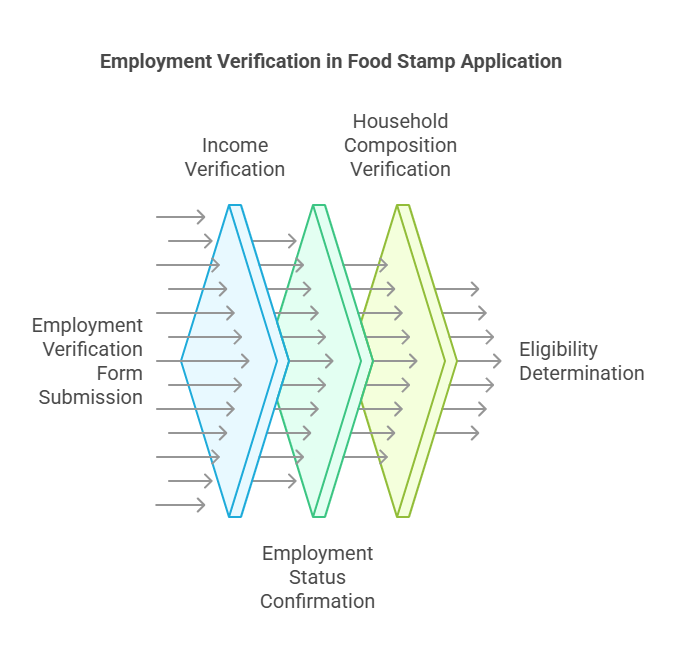
The food stamp application process is designed to assess a household’s financial need, ensuring that assistance is directed to those who truly need it. The employment verification form is critical in this assessment process as it helps verify two key aspects of eligibility:
- Income Verification: One of the primary components in determining food stamp eligibility is household income. This includes wages, salaries, benefits, and other forms of income. The form verifies whether the applicant’s income meets the federal poverty guidelines that determine the level of assistance they can receive.
- Employment Status: Food stamp programs require that applicants provide details of their employment status, including their job history, current employment, and earnings. The verification form serves as an official declaration of an applicant’s job status, helping authorities determine if they qualify for the program based on employment history.
Additionally, the employment verification form helps verify the household composition, as the number of people living in a household can affect eligibility. Therefore, an accurate completion of the form is necessary to avoid misrepresentation or errors that could cause delays or rejections.
Understanding the Importance of Employment Verification Forms in Ensuring Eligibility
The importance of the employment verification form cannot be underestimated for both the applicant and the administering agency. For applicants, the form is their opportunity to demonstrate their need for food assistance, providing essential proof to support their case. For the agency, the form is used to verify that the applicant meets the eligibility criteria based on current income and employment status.
Without this form, authorities would lack the documentation necessary to determine eligibility, resulting in longer wait times and potential errors in the approval process. Therefore, it’s vital for applicants to ensure that they complete the employment verification form correctly and submit all necessary supporting documents.
How the Employment Verification Form Is Completed
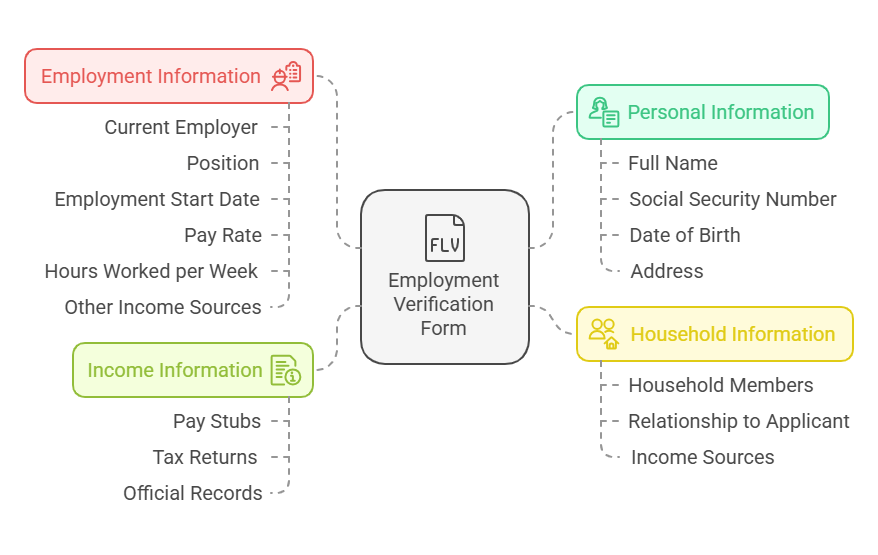
The completion of the employment verification form for food stamps typically requires the applicant to fill out personal details, such as their name, address, and contact information. The form will also ask for information regarding household members and their income sources. The exact information required may vary by state and county, but generally, the form will include:
- Personal Information: Full name, Social Security Number (SSN), date of birth, and address.
- Employment Information: Current employer, position, employment start date, pay rate, hours worked per week, and any other source of income.
- Household Information: Information about all members of the household, their relationship to the applicant, and their income sources.
- Income Information: Documentation of pay stubs, tax returns, or any other official records that support the income claims made by the applicant.
Once the necessary sections are completed, applicants are typically required to submit the form to the relevant authorities, either online, via mail, or in person at a local office. It is crucial for applicants to attach any required supporting documentation, such as pay stubs or bank statements, to validate the information provided.
Submitting the Employment Verification Form
The submission process for the employment verification form varies depending on the applicant’s state or county. However, the form is typically submitted to the local Department of Job and Family Services (JFS) or another agency responsible for administering food stamp benefits.
In many cases, applicants can complete the form online, streamlining the process for faster submission. Alternatively, some states may require in-person submission to ensure all necessary documents are provided.
Each state or county may have different submission rules, and some may even offer multiple ways to submit the form. It’s important to review the specific guidelines provided by the local food stamp program to ensure all requirements are met.
Key Takeaways:
- The employment verification form for food stamps is an essential part of the application process for the Supplemental Nutrition Assistance Program (SNAP).
- This form is used to verify an applicant’s income, employment status, and household composition to determine eligibility.
- The completion of the form requires accurate information about the applicant’s job history, current employment, and household income.
- Properly submitting the form and supporting documents to the relevant authorities is necessary to ensure smooth processing and approval.
Process, Requirements, and Best Practices for Employment Verification Forms for Food Stamps
Step-by-Step Process for Completing the Employment Verification Form for Food Stamps
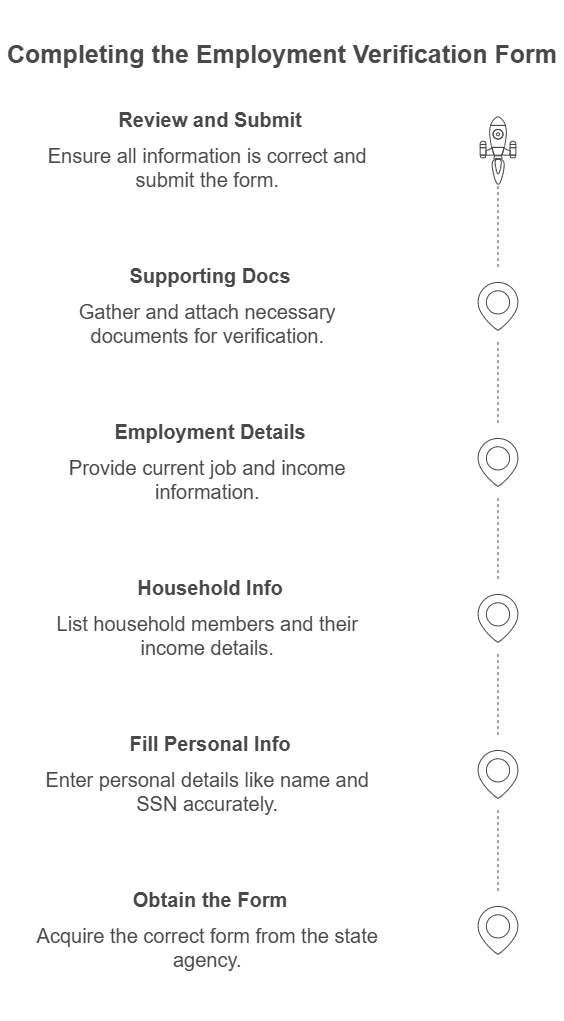
Completing the employment verification form for food stamps is a crucial step in the application process for the Supplemental Nutrition Assistance Program (SNAP). To ensure that your application is processed quickly and accurately, it’s important to follow the correct steps. Here is a step-by-step breakdown of how to complete the employment verification form:
1. Obtain the Form The first step in the process is obtaining the correct employment verification form for food stamps. This form can typically be found on the website of your state’s Department of Job and Family Services (JFS) or a similar state agency. You can download and print the form or, in some cases, complete it online if that option is available.
2. Fill in Personal Information Once you have the form, the first section will typically require you to fill in personal information, including:
- Your full name
- Social Security Number (SSN)
- Date of birth
- Contact information, including your address and phone number
- Citizenship status (in some cases)
Make sure to double-check your personal information to avoid any errors that could delay the approval process.
3. Complete Household Information Next, you’ll need to provide details about your household. This section will ask you to list all individuals living in your home, including:
- The name and relationship of each household member to you
- The Social Security Numbers of other household members (if applicable)
- The income earned by each member of the household
This information helps the authorities assess whether your household meets the eligibility criteria based on the total income of all members.
4. Provide Employment Information The next section of the form is designed to verify your employment status. Here, you’ll need to provide details about your current job and income. Some of the key fields include:
- Employer’s name and contact information
- Job title or position
- Start date of employment
- Work schedule (e.g., hours worked per week)
- Pay rate (e.g., hourly wage, salary)
- Pay frequency (e.g., weekly, bi-weekly, monthly)
If you have multiple jobs or receive income from other sources, you’ll need to provide information about those as well. This section may also ask about any other financial assistance or benefits you receive, such as child support or unemployment benefits.
5. Submit Supporting Documentation Along with the employment verification form, you may be required to submit supporting documentation to verify the accuracy of the information you’ve provided. Commonly requested documents include:
- Recent pay stubs (typically the last two to four pay stubs)
- Tax returns (particularly if you are self-employed or have other income)
- Bank statements (to show deposits or additional income sources)
- Employment letters (if applicable, from your employer confirming your employment)
Be sure to include all required documents to avoid delays in the approval process. If the documents are not in the required format, or if you miss a document, the agency may ask you to resubmit them, which could significantly delay the process.
6. Review and Submit the Form Before submitting the form, it’s essential to carefully review all the information you’ve provided. Double-check that all sections are complete, all required documents are attached, and your personal and employment details are accurate. Any missing or incorrect information can result in delays or the rejection of your application.
Once you’re sure that everything is correct, submit the form. Most states allow you to submit it either online, by mail, or in person at a local office. The method of submission depends on your state’s guidelines, so make sure you are following the correct procedure.
Supporting Documentation for Employment Verification Forms
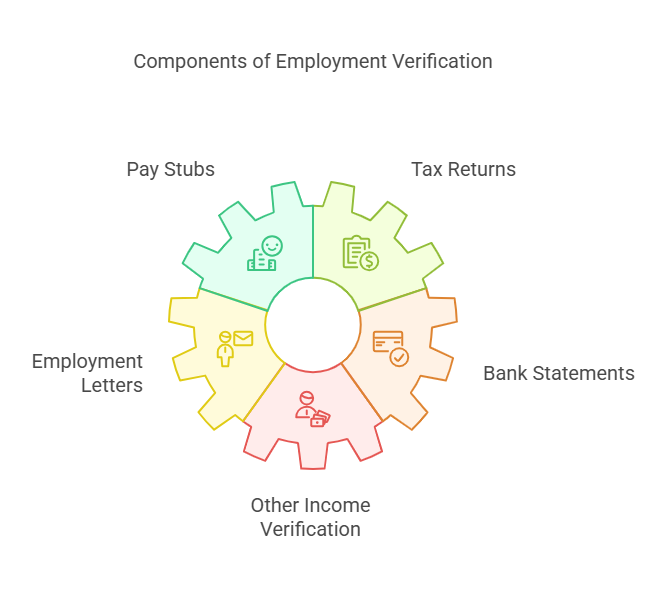
In addition to the employment verification form for food stamps, you will likely need to provide supporting documents to verify your eligibility. These documents are used to confirm the information you’ve provided on the form and ensure that it’s accurate. Here are some common types of supporting documentation:
1. Pay Stubs Pay stubs are one of the most common forms of supporting documentation requested by food stamp agencies. They provide detailed information about your earnings, including your hourly rate, the number of hours worked, and your total wages. Generally, you will need to provide the most recent pay stubs, typically the last two to four.
2. Tax Returns If you’re self-employed or have other forms of income (such as rental income or freelance earnings), you may be asked to provide a copy of your tax returns. Tax returns provide a detailed overview of your financial situation, including any deductions or exemptions you’ve claimed.
3. Employment Letters An employment letter is often required if you are recently employed or have a nontraditional job arrangement. This letter should come from your employer and confirm your employment status, job title, salary, and hours worked.
4. Bank Statements Bank statements can help verify deposits from employers or other sources of income. If you receive income through direct deposit or have any other form of automatic payment, you may need to provide recent bank statements.
5. Other Income Verification If you receive income from other sources (such as child support, alimony, or government benefits), you may need to provide documentation to prove the amount and frequency of these payments. This helps ensure that all of your income is taken into account when determining your eligibility for food stamps.
Common Mistakes to Avoid When Completing the Employment Verification Form
Filling out the employment verification form for food stamps can be a detailed and sometimes complicated process, but ensuring accuracy is critical to avoid delays. Below are some common mistakes to avoid:
1. Incomplete Information One of the most common mistakes applicants make is failing to fill out all sections of the form completely. Missing information, whether it’s personal details, household composition, or income verification, can result in significant delays in processing. Ensure that every field is filled in and all relevant information is provided.
2. Inaccurate Income Information Accurate income reporting is crucial. Underreporting or misrepresenting income can result in disqualification or even legal consequences. Be sure to provide the most up-to-date and accurate income figures. If you have income from multiple sources, include them all.
3. Missing Supporting Documents Many applicants forget to include required supporting documents, such as pay stubs, tax returns, or employment letters. Missing documents can delay the verification process, causing unnecessary setbacks. Always double-check the list of required documents before submission.
4. Failing to Report All Household Members If you fail to include all members of your household on the form, the agency may not accurately assess your eligibility. Be sure to list everyone living in your home, even if they do not contribute financially.
5. Incorrect Submission Submitting the form incorrectly (e.g., not following the correct submission method or submitting incomplete forms) is another mistake applicants can make. Verify the submission guidelines for your specific state or county and ensure you’re following the right steps.
Best Practices for Completing the Employment Verification Form
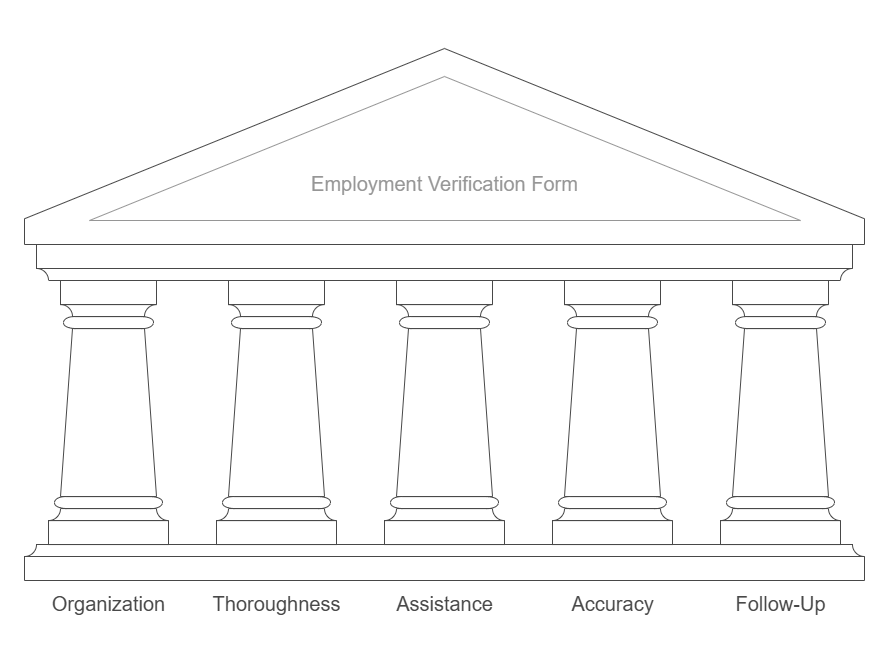
To help ensure a smooth and efficient process, here are some best practices for completing the employment verification form for food stamps:
1. Stay Organized Keep all your documentation organized and in one place. This will make it easier to fill out the form and find the necessary information. Maintain a folder with your pay stubs, tax returns, and other relevant documents to make the process more efficient.
2. Be Thorough Take your time to read each question on the form carefully, and make sure to answer everything thoroughly. Don’t skip any sections, even if the information doesn’t seem to apply to your situation.
3. Seek Help If Needed If you’re unsure about how to complete any part of the form or have questions about supporting documentation, seek help. Many food stamp agencies offer assistance, and you can often find guidance on their websites or by calling customer service.
4. Double-Check for Accuracy Before submitting your form, review everything to ensure that all the information is accurate and up to date. Accuracy is key to avoiding delays and ensuring that your application is processed correctly.
5. Follow Up Once you’ve submitted the form and supporting documents, keep track of the submission. If you don’t hear back within the expected timeframe, follow up with the relevant agency to ensure your application is being processed.
How Rapid Hire Solutions Can Help
Rapid Hire Solutions offers valuable services to applicants who need assistance with employment verification forms for food stamps. Their services help streamline the process by providing accurate and timely verification of employment information, ensuring that all forms are filled out correctly and that necessary documentation is submitted. Rapid Hire Solutions can also offer advice on best practices for food stamp applications and help applicants navigate any challenges they may encounter.
Legal Aspects of Employment Verification Forms for Food Stamps
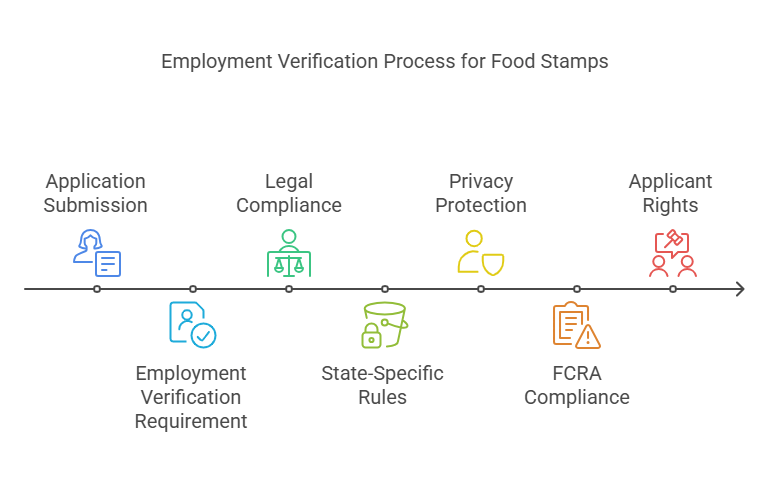
When applying for food stamps (SNAP benefits), the employment verification form plays a critical role in the process, and understanding the legal framework surrounding it is essential. Various laws and regulations govern eligibility verification for food stamps, including the rights of applicants and the obligations of both state agencies and applicants during the verification process. Let’s explore the key legal aspects related to employment verification forms for food stamps:
1. Fair Housing and Employment Laws
The Fair Housing Act (FHA) and various employment laws protect individuals from discrimination in the housing and employment sectors, including during food stamp applications. This means that any income verification or eligibility determination based on employment should be done fairly and equitably, regardless of race, gender, age, religion, or disability status.
In the context of food stamps, the verification process must adhere to these non-discrimination principles. Applicants should not be unfairly denied benefits based on personal attributes not related to their eligibility for assistance, such as immigration status or previous criminal history, except in cases specifically outlined by law.
2. State-Specific Rules for Employment Verification
Each state has specific regulations governing the application process for food stamps. While the federal Food and Nutrition Act provides the overarching framework, individual states set the specific rules regarding:
- What documentation is acceptable for verifying income and employment.
- How frequently the verification process must be updated.
- The rights of applicants to dispute incorrect decisions or seek recourse.
In Ohio, for example, applicants may be required to submit income verification forms through the Ohio Department of Job and Family Services (ODJFS), whereas in California, the process may involve different forms and submission protocols. Understanding your state’s specific rules will help ensure compliance and avoid any issues with your application.
3. Privacy Rights and the Protection of Personal Information
When submitting an employment verification form, applicants must provide sensitive personal and financial information, such as social security numbers, pay stubs, and tax returns. This information is protected under federal privacy laws, such as the Privacy Act of 1974 and the Health Insurance Portability and Accountability Act (HIPAA).
Applicants have the right to expect that their personal information will be handled securely and confidentially by the relevant authorities. States are legally bound to protect your data and may only use it for the purposes of processing your food stamp application.
4. Fair Credit Reporting Act (FCRA) and Employment Verification
Although the Fair Credit Reporting Act (FCRA) is primarily associated with credit checks, it can also impact employment verification for food stamps. The FCRA regulates the use of consumer reports for any purpose, including employment or income verification.
When verifying employment through third-party providers or employment history databases, it’s important for both applicants and agencies to ensure they comply with the FCRA’s requirements. Applicants should be aware that they have the right to request a copy of any consumer report used during the verification process and to dispute any inaccuracies.
5. Your Rights as an Applicant
When filling out an employment verification form for food stamps, applicants have certain rights, including:
- Right to Privacy: You are not required to disclose information that is not directly relevant to your eligibility for food stamps.
- Right to Appeal: If your application is denied or you disagree with a determination made based on the verification process, you have the right to appeal the decision. Most states provide an administrative process for resolving disputes.
- Right to Assistance: If you need help completing the employment verification form, many states provide assistance through local food stamp offices or community organizations.
Frequently Asked Questions (FAQs)
To provide further clarity, here are five frequently asked questions (FAQs) about employment verification forms for food stamps:
What is the purpose of the employment verification form for food stamps?
The employment verification form is used to verify your employment status, income, and household composition. This information helps determine if you meet the eligibility criteria for food stamps (SNAP benefits). Without accurate employment verification, the application cannot be processed correctly.
What documents are required with the employment verification form?
In addition to the form itself, you will need to provide supporting documents such as:
- Pay stubs (for the last two to four pay periods)
- Tax returns or W-2 forms (for self-employed individuals)
- Employment verification letters
- Bank statements (if you receive direct deposits)
- Any other relevant financial documents
The required documents may vary depending on your state, so it’s important to check your state’s guidelines.
How long does it take to process the employment verification form for food stamps?
Processing times can vary depending on your state’s guidelines and how quickly you submit the necessary documents. Typically, the food stamp application process can take anywhere from a few days to a few weeks. If you provide all necessary information and documents, the process can be faster. However, incomplete forms or missing documents may delay processing.
What happens if I make a mistake on the employment verification form?
If you make an error on the form, it’s important to correct it as soon as possible. An incorrect form can delay the processing of your application. If the mistake is discovered after submission, you may be asked to resubmit the form with the corrected information. In some cases, this may affect your eligibility or the benefits you receive, so it’s crucial to be thorough and accurate.
Can I submit the employment verification form online?
Many states allow applicants to submit the employment verification form and supporting documents online. Online submission is typically the quickest method, but it’s important to ensure that all required documents are in the correct format (e.g., PDF or JPEG) and that the submission guidelines are followed. You can also submit the form in person at your local office or by mail, depending on your state’s preferences.
Conclusion: Key Takeaways
Completing the employment verification form for food stamps is a critical step in ensuring that you qualify for food assistance under the SNAP program. The form plays a significant role in determining your eligibility by verifying essential information such as income, employment status, and household composition.
It is crucial to be accurate and thorough when filling out the form to avoid delays in processing or complications that could affect your eligibility. Providing all necessary documentation, such as pay stubs and tax returns, will help streamline the process.
Furthermore, understanding the legal aspects surrounding the employment verification form—including privacy rights, state-specific rules, and your rights as an applicant—ensures that you are fully informed throughout the process. If you encounter any issues, there are resources available to help you, including the option to appeal decisions and seek assistance if needed.
By following the necessary steps and ensuring accuracy, applicants can successfully complete the food stamp application process and receive the benefits they need.
